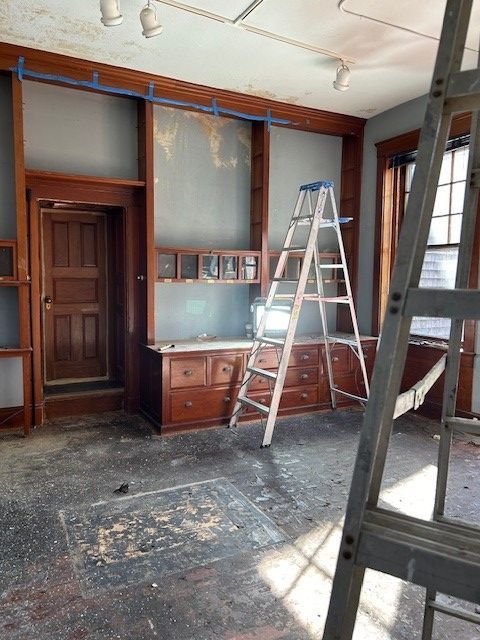Interior Conservation Work Has Begun!
With a new grant from the Community Preservation Act (CPA), we have now moved inside – to begin work on the interior of the historic components of the Vestal Street Observatory. We are very excited!
After much conservation work completed to the exterior, with a CPA grant as well, we have a weather tight exterior which allows us to start the interior work. In the Astronomical Study, original plaster – possibly with a skim coat of parging – walls have been cleaned up. When I note cleaned – it’s the removal of any loose paint only and no walls have been filled so all that original 1922 “bumpiness” and pitting of those walls remains. A primer coat is being applied to the walls and then we will return to the original cream color on the walls. The circa 1987 blue wall-to-wall carpeting has been removed, as well as the layer of tiles from the 1950s or so. We have revealed the original 1922 wood floor which is beginning its conservation as well. Unfortunately, there was a layer of tarpaper placed between the wood floor and tiles, with a TON of glue, so the work on the floor is a bit more extensive than we had originally hoped. While we looked at some areas under the carpet initially, it did not reveal the extent to the damage of the wood floor. But Adam Zanelli of Nantucket Heritage Painters, and Pen Austin, lime plaster and historic finish expert extraordinare, have worked together to figure it out. Adam and Pen are also working out the final planning phases of work to the original woodwork. We will only be touching areas of loss or damage, matching the tint of the wood, and applying shellac which is what most of the woodwork is coated in.
In the Pillar Room and Dome Room, they are also working to deal with the layers of paint (mostly from the last thirty years) and in the cellar dealing with the parging that is on most of the walls. The parging was likely for two reasons. To make the room more inviting and cleaner – it was used for storing glass plates and had the boiler way back in the day (sounds horrific but I believe they thought the boiler would keep the glass plates of the night sky dry – and it likely did) and to keep the room waterproof (which it did at first but it has not in many years and has been failing). The parging is likely not original – it seems to be a different vintage and make-up from the one up in the Study.
There is more to come – and a lot of woodwork in other areas that will get the same treatment as the Study. We also have concrete floors with some issues to address, as well as electrical and a new HVAC system. So stay tuned!
JNLF
Recent Posts





